After the expensive financial flop that was Sleeping Beauty, Walt Disney seriously considered shutting down his studio’s animation division. Fewer than half of his animated films had been financial successes, after all, and although World War II could certainly be blamed for some of that, it could not be blamed for the financial failures of the post war Alice in Wonderland and Sleeping Beauty, or the only middling financial success of Lady and the Tramp, which for technical reasons had been issued in two versions, adding greatly to the film’s budget—and cutting into profits.
But Walt Disney had also picked up Dodie Smith’s The Hundred and One Dalmatians and loved it. It had everything needed for a major Disney hit: a grandiose, over the top villain, a tight, simple plot, adorable puppies, and a happy ending. Oh, a few things would need changing – that almost but not quite doggie threesome between Pongo, Missus and Perdita would just not work for a children’s film aimed at an American audience, in his opinion, and some of the characters would have to go. And the final scenes needed something more. Maybe a car chase. An over the top car chase. That could work.
That left just one problem: how to animate 99 puppies. With spots. Without repeating the financial issues of Lady and the Tramp and the outright disaster that was the gloriously detailed work of Sleeping Beauty.
Xerox had begun developing a photocopying process before Word War II. By the 1950s, a commercial version was available for businesses, but it focused on paper, not film. Ub Iwerks (the co-creator, with Walt Disney, of Mickey Mouse) was impressed enough by what he saw to work with Xerox to adapt the technology for film, and the final process allowed animator drawings to be printed directly onto cels. This accomplished two things: one, it freed Disney from the need to hand ink each and every animated cel (the process which had significantly raised the costs of Alice in Wonderland and Sleeping Beauty, and the costs of releasing two versions of Lady and the Tramp) and it meant that instead of having to hand draw 99 little Dalmatian puppies, Disney could, for all intents and purposes, just photocopy them.
The resulting process did lead to some sloppiness: if you watch the Blu-Ray edition closely, and even not all that closely, you can still see the original pencil marks around some of those black lines. The lines, too, are far thicker than the delicate lines used in earlier Disney animated pictures, something that would not be improved until The Rescuers (1977), and often uneven. This might be the one Disney film you’re better off not seeing in Blu-Ray, is what I’m saying. It also reportedly led to one error: viewers who have counted all of the puppies in the final scene have claimed that it has about 150 puppies, not 99, probably thanks to the ease of photocopying the puppies. (I didn’t try to verify this.)
And since the xerography process could initially only reproduce black, not colored lines, animated characters from One Hundred and One Dalmatians through The Rescuers, and even most of the characters in The Rescuers and later films, were all outlined in black, in strong contrast to the colored outlines that Disney had used to such great effect in Fantasia and some of the Sleeping Beauty sequences. It also forced animators to move away from the more realistic animation used for the dogs in Lady and the Tramp (which did not have to be drawn with hard, black lines) to a more cartoonish look used for One Hundred and One Dalmatians and pretty much every animated animal in a Disney film until Beauty and the Beast in 1991.
Walt felt it was a step back to earlier, cruder animation techniques, and disliked it. But if less artistic, xerography was also considerably cheaper, saving Disney millions in production costs. The process was so successful that Disney almost completely abandoned the process of hand inked cels, using xerography for almost all of their features from The Sword in the Stone until The Little Mermaid, until the process was again replaced for The Rescuers Down Under and further films by a new system called CAPS, developed by a little firm called Pixar. Xerography was efficient enough that, with one major exception that we’ll get to, even films that did not do particularly well at the box office could still break even.
Perhaps not coincidentally, however, the films produced in the 28-years between One Hundred and One Dalmatians and The Little Mermaid, with the very arguable exceptions of The Many Adventures of Winnie the Pooh and The Rescuers, are less well regarded, both in critical and popular opinion. Perhaps because the earlier films were all, for a lack of better term, “hand created,” versus the later, “machine created” films – although films from The Little Mermaid onward also used computer animation and other “machine created” images. Perhaps because, as we’ll see, One Hundred and One Dalmatians really does mark a general decline in Disney animation that, despite bright moments here and there, continued up until Who Framed Roger Rabbit and The Little Mermaid in the late 1980s.
Or perhaps because these films have been seen as “cartoons,” not “art,” – a perception that Disney itself tends to perpetuate. The Disney Art stores that dot the Disney theme parks, for instance, typically sell art focused almost entirely on the films before Sleeping Beauty and after The Little Mermaid (along with Mickey Mouse and Winnie the Pooh) ignoring the multiple films that came in between. This isn’t entirely because of a cartoon versus art approach, of course – the Disney Art stores also tend to focus on popular characters, and for whatever reason, characters from, say, The Sword and the Stone do not sell merchandise, high art or not. But still, head into a Disney Art store, and you will generally be left with the impression that the films from One Hundred and One Dalmatians through Oliver and Company are not classified as “art.”
But for One Hundred and One Dalmatians, which featured three cartoonish villains, the cartoonish look worked. It helped, certainly, that most of the dogs in the film were black and white, or, for a short period at the film’s end, very black and covered in soot. Also helping the budget and the overall look of the film: simple backgrounds, the nearly complete abandonment (in this film) of any attempt to give most scenes a three dimensional look, and a tight rewriting of the plot to ensure that the background artists in this film did not have to paint all that many backgrounds.
But also helping was one element that Disney could not take complete responsibility for: Cruella de Vil, the sort of person who not only wants to KILL PUPPIES (gasp) but also PUTS HER CIGARETTES OUT IN PEOPLE’S CUPCAKES. Really, Cruella. I get your point about having an existence so miserable that only a fur coat made with the finest, softest puppy fur can cheer you up, but what did those cupcakes ever do to you? For that matter, did it occur to you that just maybe, a cupcake or two would have made your existence slightly less miserable?
Most of her characterization is lifted from the book, right down to the black and white hair, the atrocious manners, the puppy obsession, and the terrible driving. Oh, a few elements were toned down – notably the hints that she’s a direct descendent of an actual devil, possibly not something that Disney wanted to include in a film largely aimed at young American children. And Cruella is – very arguably – slightly more sympathetic here. She doesn’t put pepper in everyone’s food, which is nice; she admits that she lives a miserable, sad existence (possibly, Cruella, because you haven’t figured out that happiness is a nice warm puppy—which is not exactly the same thing as a nice warm coat made from puppies); and she has to deal with two highly incompetent henchmen.
Against this, she’s also a lot meaner than she was in the book. She makes fun of Roger’s songwriting career. I may possibly have clapped out loud when Roger’s revenge song “Cruella de Vil, Cruella de Vil” turns out to be a major hit. She’s dismissive towards Anita and rude to poor Nanny. She splatters ink over Pongo and Roger – ok, it’s funny, but it’s also cruel. And she hits her two incompetent henchmen. A lot. I mean, I get her frustration, but when the two of them decided to watch TV instead of carrying out her orders, I was completely on their side. She smokes constantly, and, given her carelessness with cigarettes, I have no idea why she isn’t constantly set on fire. And she is the worst driver ever. In many ways the biggest question of the film is: how did Cruella not kill puppies with her car before this? Or did she, and the police were just to terrified of her to arrest her? I could see that.
But the best thing about Cruella, from Disney’s point of view, is that she is so cartoonish and over the top that the rest of the film could be designed to have a similar feel, and look – leading to the budget savings in animation noted above. And she made adults laugh – even as their children desperately worried about the puppies, partly because of her physical movements, partly because of her dialogue and voicing. Betty Lou Gerson would later be named a Disney Legend for voicing the part, possibly because of her marvelous way of shrieking “IMBECILE!” in a lovely accent straight from the BBC – well, if BBC News ever got that excited or decided to go on a puppy rampage.
If Disney mostly stayed with the book Cruella, they did, however, make other changes: turning Roger from a government financial wizard to a songwriter –allowing Disney to sneak two songs into the film; eliminating one of the Nannies, and also, alas, eliminating the decision made by the Nannies to take over traditional male jobs; allowing Colonel Tibbs the cat to start rescuing the puppies before Pongo and Perdita show up.
All small changes, but it was enough to upset small me – I saw it right after reading the book for the first time, and well before I’d learned that Hollywood always changes books, so my little hopes of getting to see my book on screen were completely dashed. I wanted Missis and Perdita and both Nannies and – and I’m afraid that my childhood disappointment hasn’t quite gone away.
And, as Tor.com readers pointed out in the last post, it is somewhat eyebrow raising that, with the exception of Mr. De Vil, the minor characters Disney chose to eliminate mostly happen to be women – and more specifically, women in non-traditional roles: Nanny Butler, who dons the uniform of a male butler without a blink, and does her work efficiently and with style; Willow, a military cat transformed to, well, a male military cat.
All this said, the rest of the film has held up relatively well, thanks to sight gags of dogs that resemble their owners, lots of adorable puppies, quick cameos from the dogs of Lady and the Tramp, a glorious moment where the dogs of London join together to save the puppies through barking (to the distress of their human pets), Cruella slapping incompetent people across the face, and the cartoon parodies of 1950s television, slightly expanded in the recent Blu-Ray edition. Contemporary audiences loved all this as well. One Hundred and One Dalmatians was an immediate financial success, though it did generate some unexpected criticism from one corner: Dalmatian experts concerned that small children would demand small but high energy Dalmatian puppies without necessarily knowing how to care for them. These concerns proved somewhat valid, and in turn led to the creation of several Dalmatian puppy rescue organizations.
For Disney, which only had to worry about cartoon dogs, not real ones, the financial success saved the animation studio. It also encouraged the studio to focus on two things that had so far seemed profitable: animated features based on British properties, and adorable animals. The Sword in the Stone, coming up next.
Mari Ness lives in central Florida.










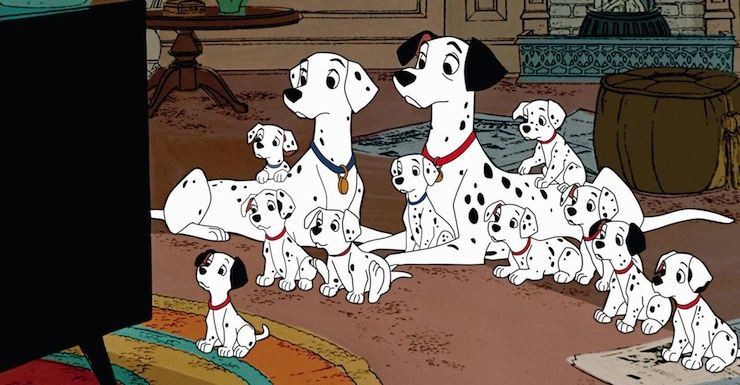
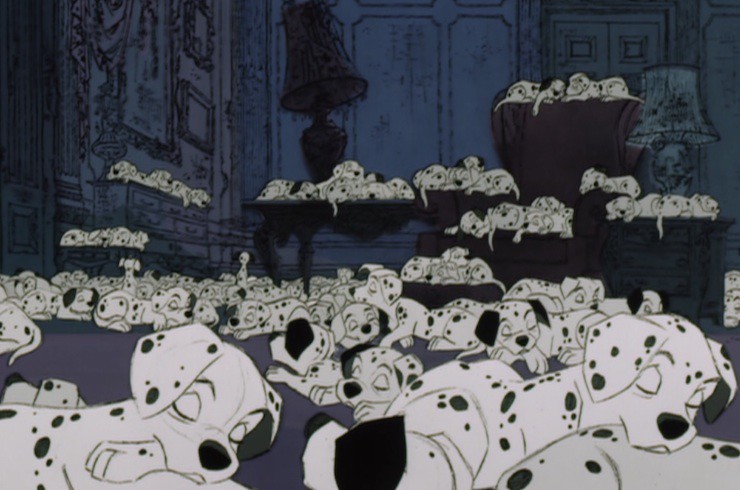
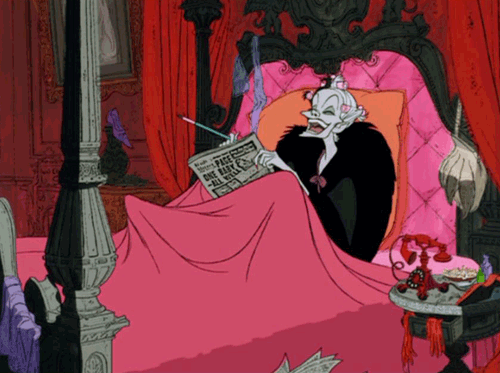
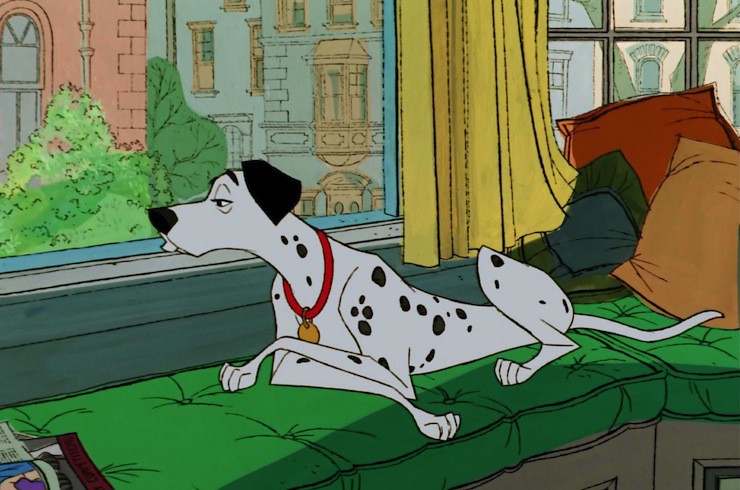
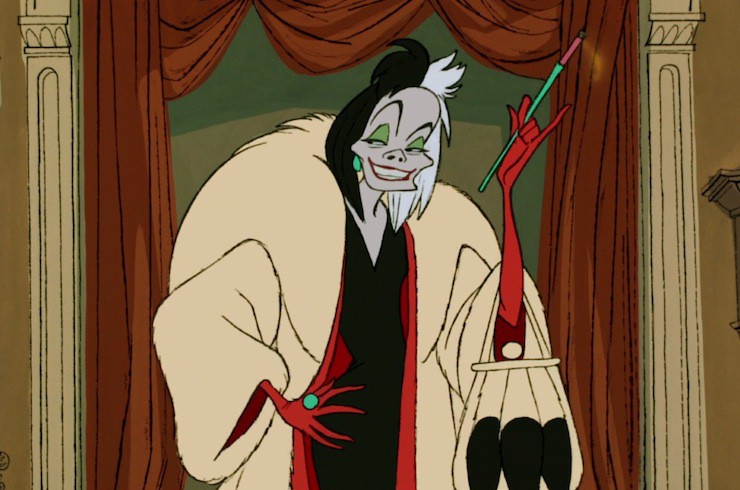
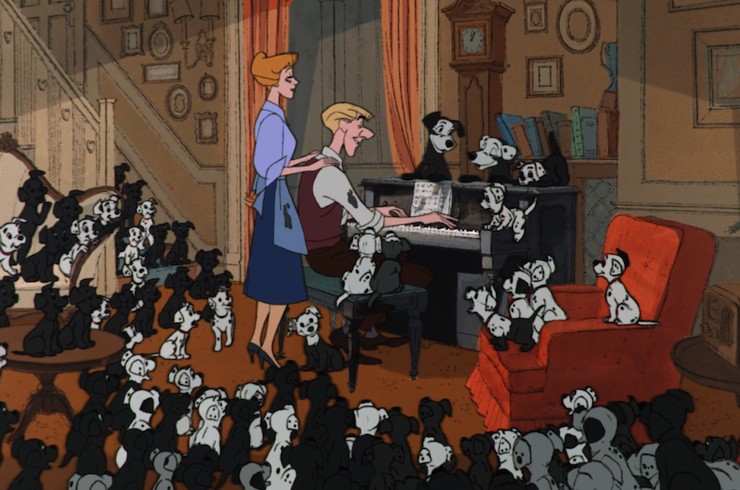
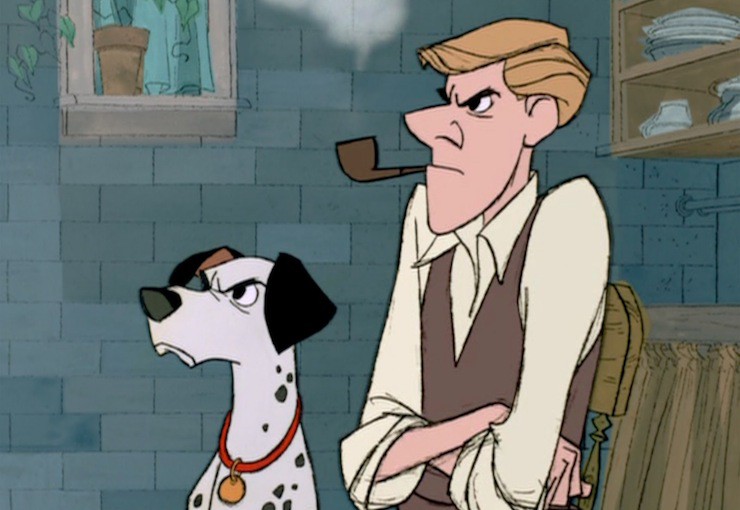
I really enjoyed reading about people’s reactions to the book in the earlier post. I had never really heard of the book!
Anyway, the new Xerox technique definitely does seem to have a less polished and flatter look – I agree with you that it does kind of fit this movie (I love the Robin Hood movie but the fact that the Snake is downright FUZZY looking at times is really irritating to me). I think the different Disney ‘ages’ are fun to analyze as well…and it’s kind of neat being the perfect age for the future Disney Renaissance – Little Mermaid is probably the earliest movie I remember being really in to and so probably a big part of what shapes my perception of Disney as fairy tales-musicals-romance. But there are a lot of upcoming movies in the less regarded area that I have a fond spot in my heart for too :)
I thought Roger and Anita’s meet cute in the park is pretty adorable :)
I also like the dog food commercial (and if you watch closely, you can see the spokesperson making an alarmed expression when they turn it off midway through).
I hadn’t necessarily known the chronology before, but this is definitely the first of Disney’s “hastily-sketched backgrounds” phase of animated movies. Which I know was actually a stylistic choice, not just a monetary choice — but look at the way the color often doesn’t quite stay in the lines — like the stacks of dishes in the lowest picture. It creates a much more … I don’t know, casual? feel to things.
The pencil-sketch aesthetic really does give the film a nicely modern (in the 50s / 60s sense) look. I like it.
If you think these backgrounds are casual, check out the backgrounds Maurice Noble did for Warner Bros. around that time. So casual they’re insane.
Bypassing Lady and the Tramp entirely?
Yeah, to be clear, not saying I dislike the style — just that it’s a significant change from what came before.
Yeah, I think the style actually does work quite well with the tone of the film. Other films, not so much.
I agree that this movie has held up quite well: Cruella, the Twilight Bark, the meet-cute, the parody TV, the visual effect of the many cute b&w puppies. And I agree that the style of animation works well with this particular material.
I saw this in the theatre as a child, probably on its initial release, and we had the LP where Lucky was the narrator of the story. That gave my family the quotation: “My tail’s froze and my nose is froze and my ears are froze and my toes are froze,” which we used to express extreme cold. Child-friendly poetry. I read the book after experiencing both the movie and the LP, so had no book-related disappointment in the film.
I remember wondering why the TV superdog Thunderbolt was a German Shepherd rather than a collie; I watched Lassie and had never heard of Rin Tin Tin. In fact, for me, the most emotionally powerful scene in the movie involved a collie. It’s the transition from the blizzard to the warm barn, complete with milk fresh from the obliging cows. That transition from freezing to warm, from scary to safe, from exhaustion to rest, from hungry to full–I find it as comforting as Disney’s famously powerful scenes of maternal love (as in Dumbo). Since I had imprinted on Lassie, the fact that a collie brings them into the barn no doubt helped make it work for me.
Honestly, I loved the flat look, because it looked somehow… unfinished and 50ies to me and I was sure they did this kind of design on purpose, not to cut costs (I love this unfinisheld look of the lines showing thorugh).
What do you think on the animated series featured in… the 90ies, I think? Where Roger and Anita and all those dogs live on a farm with Cruella as a neighbour? It certainly gave more personality to particular dog puppies, but I have strongly mixed feelings on it.
@eduardo Jencarelli – Lady and the Tramp came out before Sleeping Beauty. I skipped it because I was unable to track down the text source for the film.
@George Kaplan – Yes, but WB focused on cheap animation and simple backgrounds from the get go. This was a huge switch for Disney.
@Evanesca Feuerblut – I’ve never seen that animated series, so I can’t comment on it.
Howwww did I not notice this Watch-Read before?! I’ve never seen a lot of the older films, but will happily follow it and am reading the previous posts.
Particular thanks for your HILARIOUS commentary on the book version of “Pinocchio.” I’m currently rereading it, because sea monster, and…yeah. The movie is way different. (So is a non-animated film version which I loved as a kid, because orca whale).
I never liked 101 Dalmations much, mostly because the part where one of the minions falls in the fireplace and the ceiling starts falling down and suchlike (IIRC) terrified me, along with the scene where they lock Nanny in a room while stealing the puppies. But it has a certain charm, along with an exceptional dastardlyness of villainous intent.
@MariCats
Not always “cheap,” or not what I’d call cheap animation. A lot of Noble’s best work was done in the ’50s with Chuck Jones and Friz Freleng, during the heyday of Looney Tunes and Merry Melodies. It was sometime in the ’60s when WB went really cheap (when the logo changed to the ugly black background along with weird music). And a lot of the old guard left. And that’s all folks—for the good stuff anyway. Just watch a Road Runner cartoon from 1955, then one from 1965, and you’ll see what I mean.
There was a book published about 10 years ago, “Cartoon Modern” by Amid Amidi, that has loads of info on the changes going on in animation style at the different studios in the ’50s and ’60s, including Disney and 101 Dalmatians. If memory serves, Disney had already experimented with the more casual style in edutainment shorts by Ward Kimball.
One thing that delighted my child and I at last year’s Disneyland Hallowe’en was the actress portraying Cruella. Some mild but clever put-downs, and she had the character down SO PERFECTLY.
As I already said last time, I saw the film after reading the book many many times and it disappointed me with the absence of the Nannies and Perdita, and I think the book-Cruella was more stylish and liked (to hate) her better.
What I really loved though was the beginning with Pongo choosing a suitable mate for Roger and the scene where they met.
Reading about the behind-the-scenes decisions and technical details is really fun. Great series :)
I liked the movie much more than I expected on this watch. I don’t remember disliking it or anything, but when I think of Disney movies to watch, it didn’t even enter my mind. So I wasn’t expected much and really enjoyed it. I’ve never read the book (but I have discovered my library has it! When it’s returned, I shall get it out).
I like the style here, but I can definitely see why it wouldn’t work elsewhere. For some reason it reminds me of a few Margaret Mahy books, and that makes me happy.
This was one of my favorite Disney movies as a child along with Sleeping Beauty, Cinderella and Aristocats. (And later the Lion King and what came after. For some reason I skipped Beauty and the Beast and little mermaid as a child.)
I loooved the intro with all of the dots appearing and the casual style it had. While I love the lush hand drawn disney pictures and am Extremely sad that with studio Ghibli closing, the art is probably about to die out, for the most part I like the skwtchy unfinished style they went for. It fits very well with this movie and a few others, like Winnie The Pooh.
I find it funny that a lot of the movies from 101 dalmatians are considered to be part of a quality decline by american Audiences when they are beloved cult classics in europe.
The jungle book comes to mind, for example. Everyone, literally everyone, from little children to the elderly know the (respectively located) lyrics and melody to ‘bear neccecities’ not to mention King Louies iconic romp about wanting to be human, or just Kaa. Every single line of Kaa.
Another really popular one (though not to jungle book extremes) is Aristocats. Again everyone could hum some ‘everybody want’s to be a cat’ with you. Between Robin Hood and Winnie the Pooh there was lots of good stuff there. There are certainly some duds too, (I, personally consider sword in the stone one of them for example) but it’s far from ‘the dark disney ages’ perception around here.
Meanwhile The Rescuers a film that amerian audiences seem rather fond of, is fairly unknown around here.
“La carica dei 101” è uno dei miei film animati Disney preferiti! ^^ Commedia romantica, intrigo, azione, personaggi ben caratterizzati…
concordo con il fatto che lo stile degli sfondi si armonizzi bene con l’ ambientazione cittadina dell’ opera. Davvero spettacolare la scena della bufera di neve!
I film animati Disney del periodo avevano si un’ animazione più stilizzata, ma personaggi davvero ben caratterizzati e scene proprio appassionanti, marchio di fabbrica di Wolgang Reitherman. Per questo secondo me sono molto amati dal pubblico mentre un po meno dalla critica.
“I find it funny that a lot of the movies from 101 dalmatians are considered to be part of a quality decline by american Audiences when they are beloved cult classics in europe.”
Già!
“Another really popular one (though not to jungle book extremes) is Aristocats.”
Qui in Italia “Gli aristogatti” è stato uno maggiori successi Disney! ^^ Oggi vanno di moda le commedie animate. La Disney con questo film le proponeva decenni prima. XD
Da profano dico che non è che i film “vecchi” sono penalizzati dal blu-ray, ma quest’ ultimo a penalizzare loro! XD Un formato che va bene solo per quelli nuovissimi fatti apposta.
“I saw it right after reading the book for the first time, and well before I’d learned that Hollywood always changes books, so my little hopes of getting to see my book on screen were completely dashed.”
I felt this way when, as a child, I saw the animated film adaptation of my very favorite book (it still ranks high on my favorites list), Mrs. Frisby and the Rats of NIMH, retitled The Secret of NIMH. I was livid about that stupid magic amulet the rats give Mrs. Frisby. The whole point of the rats is their brilliance and ingenuity. That’s what allows them to save Mrs. Frisby’s house, not magic. I am still not over it.